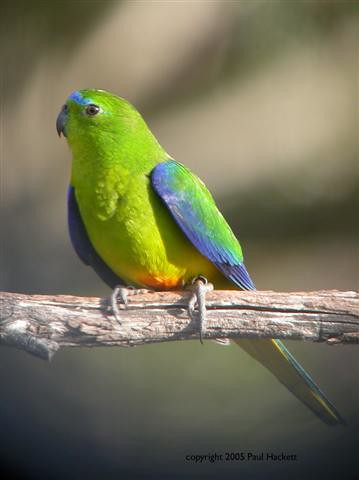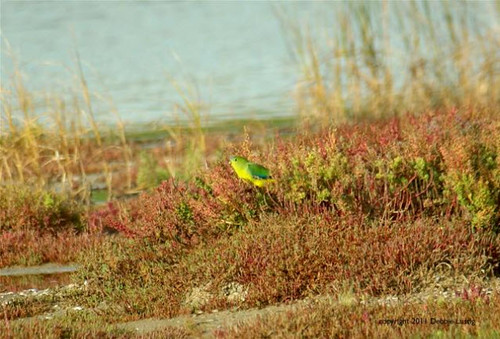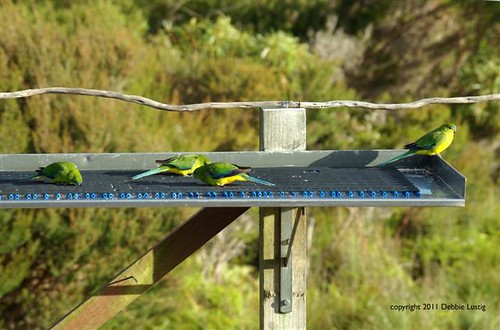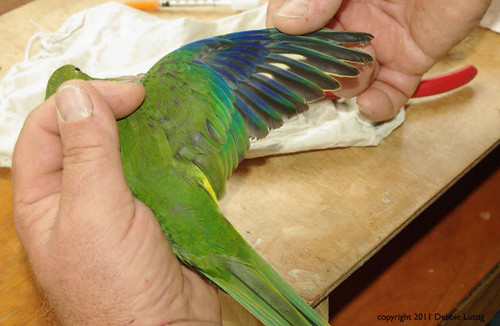On the hunt for the mysterious Orange-bellied Parrot, Australia’s most endangered bird
 Monday, September 19, 2011 at 0:30
Monday, September 19, 2011 at 0:30 As it happens, I’ve been looking for the bird all winter, visiting the unpromising-sounding Werribee sewage farm every other week. Since May, I’ve driven an hour out of Melbourne to this place, one of its last, reliable haunts.
The orange-bellied parrot is considered one of the world’s most threatened birds. It’s famous for stopping a wind farm — even though it didn’t — and for being dubbed a ‘trumped-up corella’ by Jeff Kennett — even though it isn’t. Official word is there are around 35, a number from which other threatened species have rebounded. But many in the birding community believe that it’s lost.
Still, this winter, the parrot persisted in teasing birdwatchers with brief, breathtaking appearances. Even though we’re losing it, the last, ragged remnant seems to carry on valiantly, like an old man who won’t retire.
Incredibly, if you knew where to look and luck was with you, orange-bellied parrots were easy to find. The last cohort of this species could be found lurking in the same trees, or on the same little island in the middle of the same shallow lagoon. They are nothing if not habitual.
Approaching a certain tree in May or June this year, you’d be almost guaranteed the bright-green flash of their flight and their harsh, scratchy call. Overwhelmingly, birdwatchers did.
With the dramatic decline in suitable habitat for them, we’ve chosen to develop areas they might have remained, robbing them of a future and robbing ourselves of irreplaceable biodiversity. Still they brave Bass Strait, flying southwest to breed on the Apple Isle and still they insist on overwintering in Victoria and South Australia. Don’t they realise we’ve made their lives more or less impossible?
No one can argue that the last 30 years of strenuous efforts to help ‘recover’ this species haven’t been critical. But, like a patient in intensive care, the orange-bellied parrot may go at any time and those that love it must steel themselves for the worst.
This might be easier to bear if the public could do something to help but there is very little to be done. Funding for the scientific team — not guaranteed — comes mainly from the commonwealth and three state governments. Further research on female reproduction and more intensive management of nesting sites were both recommended recently in Emu, the journal of the Royal Australian, but no special funding is available for either proposal.
The public cannot donate money to help parrots in the wild at all — although Zoos Victoria has made it an ‘ambassador animal’, which aids the captive-breeding program.
If you read Birds Australia’s orange-bellied parrot site, you’ll learn that several key planks of the current Action Plan to save the species have succeeded. There was 100% breeding participation by all the females at the Tasmanian breeding grounds in 2010/2011. Sounds good, except that only eight females bred.
The last breeding season was “productive” according to reports, with 27 juveniles produced. Sadly, for the good of the species, 21 of those young birds were removed and taken to the captive-breeding flock in order to infuse it with fresh genes. Inbreeding made this drastic step necessary.
I’ve got a thing for orange-bellied parrots. As a comfortable, modern Australian, I’m affronted that we have subtly, quietly been wiping them out. In this unfolding disaster, these birds need our help yet the world knows nothing about them. The only place on earth to see — and hear — twenty orange-bellied parrots together on the mainland is in an off-limits aviary at Healesville Sanctuary, where the birds are DNA-matched and monitored on CCTV.
It’s such old news: we’ve all but abjured responsibility to the environment. Yet, ignorant of the politics of conservation, these little buggers show up anyway, every winter.
This year, I got lucky. I saw three birds on May 14, three on May 18 and in early June, five together, more than ten per cent of the total population. Their green and yellow bodies glowed in the sun, their wings and nosebands were a beautiful, deep blue. They called their scrappy call and flew insanely quickly onto a dead tree. Ten seconds later, they rushed off somewhere else. They didn’t look as if they knew their species was going extinct.
From then on, I trooped out to the same spot, hoping for a repeat performance. Many, unfruitful visits later and a survey that drew a blank, I feel like Hachiko the dog, a Tokyo icon, which waited every day for nine years at the train station where it had last seen its dead master. Have I seen the last of the wild orange-bellied parrots?
Maybe we’re hanging on like Greyfriars Bobby, another figure of futility. The Skye terrier sat guarding its master’s Edinburgh grave for 14 years. I’m guarding something, even if it’s just hope.
Debbie runs the Save the Orange-bellied Parrot Facebook page. You can also check out Birds Australia’s Orange-bellied parrot recovery program or support the parrot through Zoos Victoria’s ‘Adopt an animal’ campaign.





